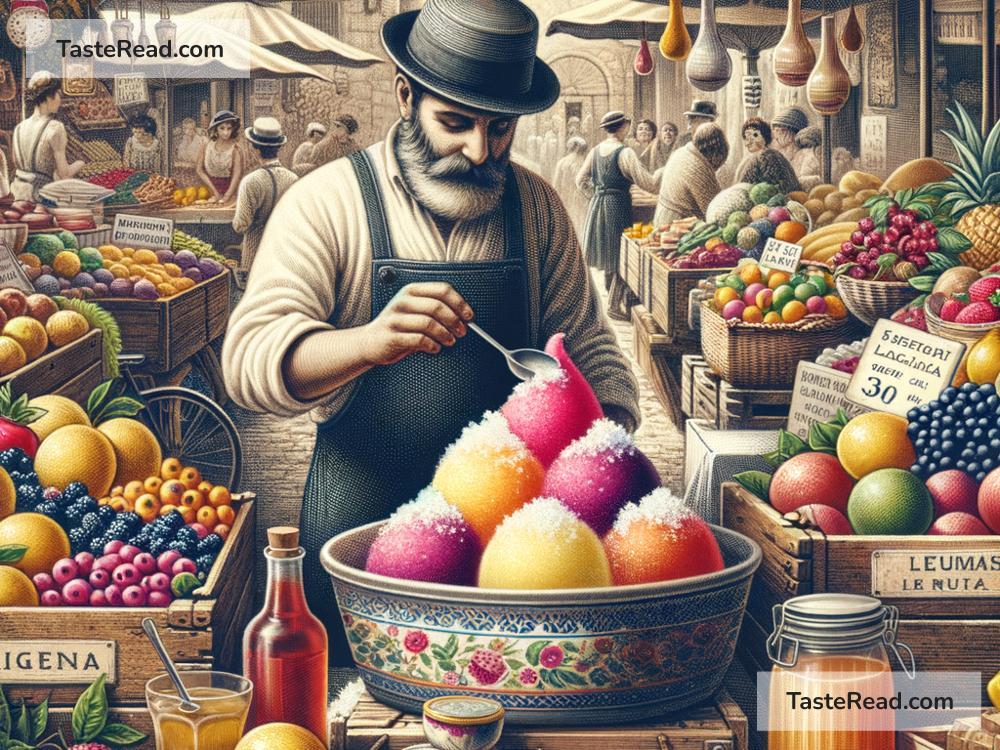Origins of the First Sorbetto in Folklore
Sorbetto, also known as sorbet, is a frozen dessert that’s loved worldwide for its refreshing texture and fruity flavor. But have you ever wondered where this chilly treat comes from? Over time, many stories and legends have surrounded its origins, blending history and folklore into an intriguing tale. Let’s explore how the first sorbetto may have been created, according to popular lore.
A Royal Beginning
One of the most famous legends about sorbetto traces its origins to the Middle East and ancient Persia. Thousands of years ago, Persian rulers enjoyed a dessert known as “sharbat,” which was a sweet, chilled drink made by mixing fruit juice, herbs, and spices with snow. The snow was collected from nearby mountains and stored in underground ice houses called “yakhchal.” These structures kept snow frozen even in the hot summer months.
According to this folklore, Persian kings, particularly King Darius I around 500 BCE, were said to enjoy sharbat as a luxurious treat. Though it wasn’t solid like today’s sorbetto, sharbat was one of the earliest attempts at creating a refreshing, icy dessert. Some people believe that sharbat inspired other cultures to experiment with frozen recipes.
Marco Polo’s Journey
Jumping forward into the 13th century, another popular legend claims that sorbetto made its way to Europe thanks to Marco Polo, the famous Venetian traveler. Marco Polo supposedly visited China during his travels and discovered icy drinks and desserts made with fruit and snow. When he returned to Italy, he brought back recipes and ideas for these treats.
However, historians debate whether Marco Polo’s story really connects to sorbetto. There’s little historical evidence to prove he specifically introduced icy desserts to Europe. Still, this charming tale remains part of the sorbetto folklore.
A Sicilian Twist
Southern Italy, and especially Sicily, plays a key role in the history of sorbetto. Many stories say that Arabs introduced the concept of frozen desserts to Sicily during their rule in the 9th century. The Arabs brought their knowledge of snow storage and the use of fruit syrups to create icy drinks resembling sharbat.
In Sicily, locals improved upon this idea, making what some consider the forerunner to modern sorbetto. They combined mountain snow with lemon juice, honey, or sugar, creating a simple but delicious frozen treat. Sicily’s climate and geography supported these efforts, with Mount Etna offering an abundant source of snow during winter.
Over time, Sicilian sorbetto became famous across Europe, and many chefs worked to refine its taste and texture.
Renaissance and Royal Indulgence
During the Italian Renaissance, sorbetto reached new heights of popularity. It became a favorite among wealthy families and royalty. One particularly interesting story involves Catherine de’ Medici, a member of the powerful Medici family in Florence. Catherine married King Henry II of France in 1533, and she reportedly introduced sorbetto to the French court.
According to legend, Italian chefs accompanying Catherine brought their expertise in frozen desserts to France, where they impressed the French nobility with their creative creations. Sorbetto became a symbol of luxury and artistry, often served at grand feasts and celebrations.
Florentine Innovation
An important turning point in the history of sorbetto came in the 17th century with a Florentine named Bernardo Buontalenti. Buontalenti was an artist, architect, and engineer, but he also had culinary talents. Many credit him with inventing an early version of gelato, a creamy cousin of sorbetto.
Buontalenti supposedly combined milk, sugar, and ice to create a new frozen dessert. While this innovation leaned more toward gelato, it helped pave the way for further experiments with sorbetto. His work demonstrates how Italian creativity transformed icy desserts into an art form.
The French Connection
Sorbetto’s popularity continued to grow in France during the reign of Louis XIV, also known as the Sun King. The French adapted the Italian method of making sorbetto and perfected their own version called “sorbet.” French chefs experimented with all kinds of flavors, including fruits, flowers, and liqueurs.
By the 18th century, advancements in technology and culinary techniques made sorbetto more accessible to the public. Ice cream parlors started opening in cities like Paris, offering both sorbetto and gelato to everyday people.
Folklore and Global Spread
Though myths and legends about the origins of sorbetto can’t always be verified, they remind us of the richness of food history. Whether it was Persian kings, Arab traders, or Italian innovators who first sparked its creation, sorbetto reflects the blend of cultures and traditions that have shaped cuisine over centuries.
Today, sorbetto continues to evolve, offering endless possibilities for flavors and textures. What started as snow mixed with fruit juice has become a beloved dessert enjoyed worldwide.
So the next time you savor a scoop of sorbetto on a hot day, take a moment to think about its fascinating origins. Whether through royal indulgence, culinary creativity, or ancient ingenuity, sorbetto is a dessert steeped in history and filled with the flavors of the past.


